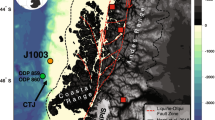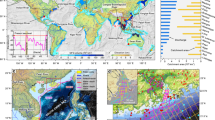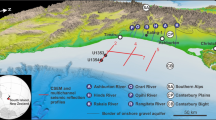Abstract
Salty and brackish groundwater has been observed at least 100 km inland in some aquifers contained within Quaternary delta plains. This phenomenon limits access to fresh groundwater resources, particularly in the densely populated deltas of Southeast Asia. However, the causes of inland salinity are unclear. Here we present borehole and geophysical data that show that in the Red River delta plain of Vietnam, salty and brackish groundwater primarily occurs in incised valleys that were formed during sea-level lowstands during the Pleistocene. During the mid-Holocene, these valleys were filled with fine-grained marine deposits containing trapped seawater. We conduct groundwater flow simulations that show that the age, thickness, and permeability of the marine sediments are the primary controls on the leaching of salty porewater into the freshwater aquifer. We find that salty groundwater originating from this trapped seawater is still present in Holocene-aged sediments with low permeability, and affects groundwater salinity in adjacent aquifers. In contrast, trapped seawater from all Pleistocene-aged sediments has been leached. We identify a number of brackish to saline delta aquifers elsewhere in Asia and throughout the world that have a similar sedimentary history, and thus are likely to be influenced by this leaching process.
This is a preview of subscription content, access via your institution
Access options
Access Nature and 54 other Nature Portfolio journals
Get Nature+, our best-value online-access subscription
$29.99 / 30 days
cancel any time
Subscribe to this journal
Receive 12 print issues and online access
$259.00 per year
only $21.58 per issue
Buy this article
- Purchase on Springer Link
- Instant access to full article PDF
Prices may be subject to local taxes which are calculated during checkout





Similar content being viewed by others
Change history
12 May 2017
In the version of this Article originally published, the titles of the Supplementary Movies, which described the hydraulic conductivities of the clay materials, were not included. This has been corrected in the online versions of this Article.
17 May 2017
The titles of the Supplementary Movies have been updated to give more detailed descriptions of the hydraulic conductivities.
References
Martínez, M. L. et al. The coasts of our world: Ecological, economic and social importance. Ecol. Econ. 63, 254–272 (2007).
Small, C. & Nicholls, R. J. A global analysis of human settlement in coastal zones. J. Coast. Res. 19, 584–599 (2003).
Chang, S. W. et al. Does sea-level rise have an impact on saltwater intrusion? Adv. Wat. Resour. 34, 1283–1291 (2011).
Henry, H. Salt intrusion into fresh-water aquifers. J. Geophys. Res. 64, 1911–1919 (1959).
Herzberg, B. Die Wasserversorgung einiger Norsseebäder. J. Gasbeleuchtung Wasserversorggung 44, 815–819 (1901).
Reilly, T. E. & Goodman, A. S. Quantitative analysis of saltwater-freshwater relationships in groundwater systems - a historical perspective. J. Hydrol. 80, 125–160 (1985).
Essink, G. H.P. O. Salt water intrusion in a three-dimensional groundwater system in The Netherlands: a numerical study. Transp. Porous Media 43, 137–158 (2001).
Nguyen, A. D. et al. Using saltwater intrusion measurements to determine the freshwater discharge distribution over the branches of a multi-channel estuary: The Mekong delta case. Estuar. Coast. Shelf Sci. 77, 433–445 (2008).
Wang, F. Dynamics of saltwater intrusion in coastal channels. J. Geophys. Res. 93, 6937–6946 (1988).
Thanh, V. C. Salinity Intrusion in the Red River Delta (Department of Civil & Environmental Engineering, 1996); http://doi.org/10.2208/proer1988.22.213
Zhang, W. et al. Numerical simulation and analysis of saltwater intrusion lengths in the Pearl River delta, China. J. Coast. Res. 29, 372–382 (2013).
Edmunds, W. M. in Paleowaters in Coastal Europe: Evolution of Groundwater Since the Late Pleistocene Vol. 189 (eds Edmunds, W. M. & Milne, C. J.) 1–16 (The Geological Society, 2001).
Shackleton, N. J. The 100,000-years ice-age cycle identified and found to lag temperature, carbon dioxide, and orbital eccentricity. Science 289, 1897–1902 (2000).
Waelbroeck, C. et al. Sea-level and deep water temperature changes derived from benthic foraminifera isotopic records. Quat. Sci. Rev. 21, 295–305 (2002).
Fisk, H. N. The loess and Quaternary geology of the lower Mississippi Valley. J. Geol. 59, 333–356 (1952).
Rao, S. V. N. et al. Planning groundwater development in coastal deltas with Paleo channels. Wat. Res. Manage. 19, 625–639 (2005).
Tanabe, S. et al. Holocene evolution of the Song Hong (Red River) delta system, northern Vietnam. Sediment. Geol. 187, 29–61 (2006).
Tran, L. T. et al. Origin and extent of fresh groundwater, salty palaeowaters and recent saltwater intrusions in the Red River flood plain aquifers, Vietnam. Hydrogeol. J. 20, 1295–1313 (2012).
Stanley, D. J. & Warne, A. Worldwide initiation of holocene marine deltas by deceleration of sea-level rise. Science 265, 228–231 (1994).
Tran, N. et al. Quaternary sedimentation of the principal deltas of Vietnam. J. Southeast Asian Earth Sci. 6, 103–110 (1991).
Remenda, V. H. et al. Isotopic composition of old ground water from Lake Agassiz: implications for late Pleistocene climate. Science 266, 1975–1978 (1994).
Wang, Y. & Jio, J. J. Origin of groundwater salinity and hydrochemical processes in the confined Quaternary aquifer of the Pearl River delta, China. J. Hydrol. 438, 112–124 (2012).
Groen, J. et al. Salinization processes in paleowaters in coastal sediments of Suriname: evidence from δ37Cl analysis and diffusion modeling. J. Hydrol. 234, 1–20 (2000).
Post, V. E. A. et al. Offshore fresh groundwater reserves as a global phenomenon. Nature 504, 71–78 (2013).
Carter, R. M., Abbott, S. T., Fulthorpe, C. S., Haywick, D. W. & Henderson, R. A. in Sedimentation, Tectonics and Eustasy: Sea-Level Changes at Active Margins (ed. Macdonald, D. I. M.) Ch. 2 (Blackwell Publishing Ltd, 1991).
Postma, R. M. Two models: global sea-level change and sequence stratigraphic architecture. Sediment. Geol. 112, 23–36 (1998).
Kooi, H. et al. Modes of seawater intrusion during transgressions. Wat. Resour. Res. 36, 3581–3589 (2000).
Post, V. E. & Kooi, H. Rates of salinization by free convection in high-permeability sediments: insight from numerical modeling and application to Dutch coastal area. Hydrogeol. J. 11, 549–559 (2003).
Delsman, J. R. et al. Paleo-modeling of coastal saltwater intrusion during the Holocene: an application to the Netherlands. Hydrol. Earth Syst. 18, 3891–3905 (2014).
Bridger, D. W. & Allen, D. M. An investigation into effects of diffusion on salinity distribution beneath the Fraser delta, Canada. Hydrogeol. J. 14, 1423–1442 (2006).
Kolker, A. S. et al. Pathways and processes associated with transport of groundwater in deltaic systems. J. Hydrol. 498, 319–334 (2013).
Mulligan, A. E. et al. The role of paleochannels in groundwater/seawater exchange. J. Hydrol. 335, 313–329 (2007).
Mills, T. et al. Time-domain electromagnetic soundings for mapping sea-water intrusion in Monterey County, California. Groundwater 26, 771–782 (1988).
Auken, E. et al. EMMA—a geophysical training and education tool for electromagnetic modeling and analysis. J. Environ. Eng. Geophys. 7, 57–68 (2002).
Auken, E. et al. Piecewise 1D laterally constrained inversion of resistivity data. Geophys. Prospect. 53, 497–506 (2005).
Zapico, M. M. et al. A wire-line piston core barrel for sampling cohesionless sand and gravel below the water-table. Groundwater Monit. Remediat. 7, 74–82 (1987).
Reeburgh, W. S. An improved interstitial water sampler. Limnol. Oceanogr. 12, 163–165 (1967).
Kerstel, E. R. T. in Handbook of Stable Analytical Techniques (ed. De Groot, P. A.) (Elsevier, 2004).
Bonnesen, E. P., Larsen, F., Sonnenborg, T. O., Klitten, K. & Stemmerik, L. Deep saltwater in Chalk of North-West Europe: origin, interface characteristics and development over geological time. Hydrogeol. J. 17, 1643–1663 (2009).
Langevin, C. D., Thorne, D. T. Jr, Dausman, A. M., Sukop, M. C. & Guo, W. SEAWAT Version 4: A Computer Program for Simulation of Multi-Species Solute and Heat Transport Techniques and Methods Book 6, Vol. 39, Ch. A22 (US Department of the Interior, US Geological Survey, 2007).
Langevin, C. D. & Guo, W. MODFLOW/M3DMS-based simulation of variable-density ground water flow and transport. Ground Wat. 44, 339–351 (2006).
McDonald, M. G. & Harbaugh, A. W. in Techniques of Water-Resources Investigations of the United States Geological Survey Chapter A1 (US Geological Survey, Department of the Interior, 1988).
Zheng, C. & Wang, P. P. A Modular Three-Dimensional Multispecies Transport Model (US Army Corps of Engineers, 1998).
Acknowledgements
The project received financial support as a research capacity building grant from the DANIDA research council (Grant 8-075-KU). P. T. K. Trang and her students from Hanoi University of Science are thanked for the chemical laboratory work and J. R. Ineson (GEUS) for linguistic support.
Author information
Authors and Affiliations
Contributions
F.L. and N.Q.P. conceived the project. L.T.T. interpreted the geologic data. L.V.T., H.V.H. and L.T.T. carried out the geophysical field data. A.V.C. carried out the geophysical data processing and interpretation. L.T.T. estimated the effective diffusion coefficient of the sediments. L.V.T., N.Q.P. and F.L. did the hydrogeological modelling. F.L., L.T.T., H.V.H. and N.Q.P. analysed and interpreted the data. F.L. wrote the paper.
Corresponding author
Ethics declarations
Competing interests
The authors declare no competing financial interests.
Supplementary information
Supplementary Information
Supplementary Information (PDF 671 kb)
Supplementary Movies
1d (K=e-6) (MOV 1542 kb)
Supplementary Movies
1d (K=e-7) (MOV 2890 kb)
Supplementary Movies
1d (K=e-8) (MOV 3824 kb)
Supplementary Movies
2d (K=e-7) (MOV 12496 kb)
Supplementary Movies
2d (K=e-11) (MOV 10233 kb)
Rights and permissions
About this article
Cite this article
Larsen, F., Tran, L., Van Hoang, H. et al. Groundwater salinity influenced by Holocene seawater trapped in incised valleys in the Red River delta plain. Nature Geosci 10, 376–381 (2017). https://doi.org/10.1038/ngeo2938
Received:
Accepted:
Published:
Issue Date:
DOI: https://doi.org/10.1038/ngeo2938
This article is cited by
-
An integrated approach based on HFE-D, GIS techniques, GQISWI, and statistical analysis for the assessment of potential seawater intrusion: coastal multilayered aquifer of Ghaemshahr-Juybar (Mazandaran, Iran)
Environmental Science and Pollution Research (2024)
-
Offshore freshened groundwater in the Pearl River estuary and shelf as a significant water resource
Nature Communications (2023)
-
Upscaling equivalent hydrofacies simulation based on borehole data generalization and transition probability geostatistics
Hydrogeology Journal (2023)
-
Geophysical investigation for seawater intrusion in the high-quality coastal aquifers of India: a review
Environmental Science and Pollution Research (2022)
-
Evaluating salinity variation and origin in coastal aquifer systems with integrated geophysical and hydrochemical approaches
Environmental Science and Pollution Research (2022)



